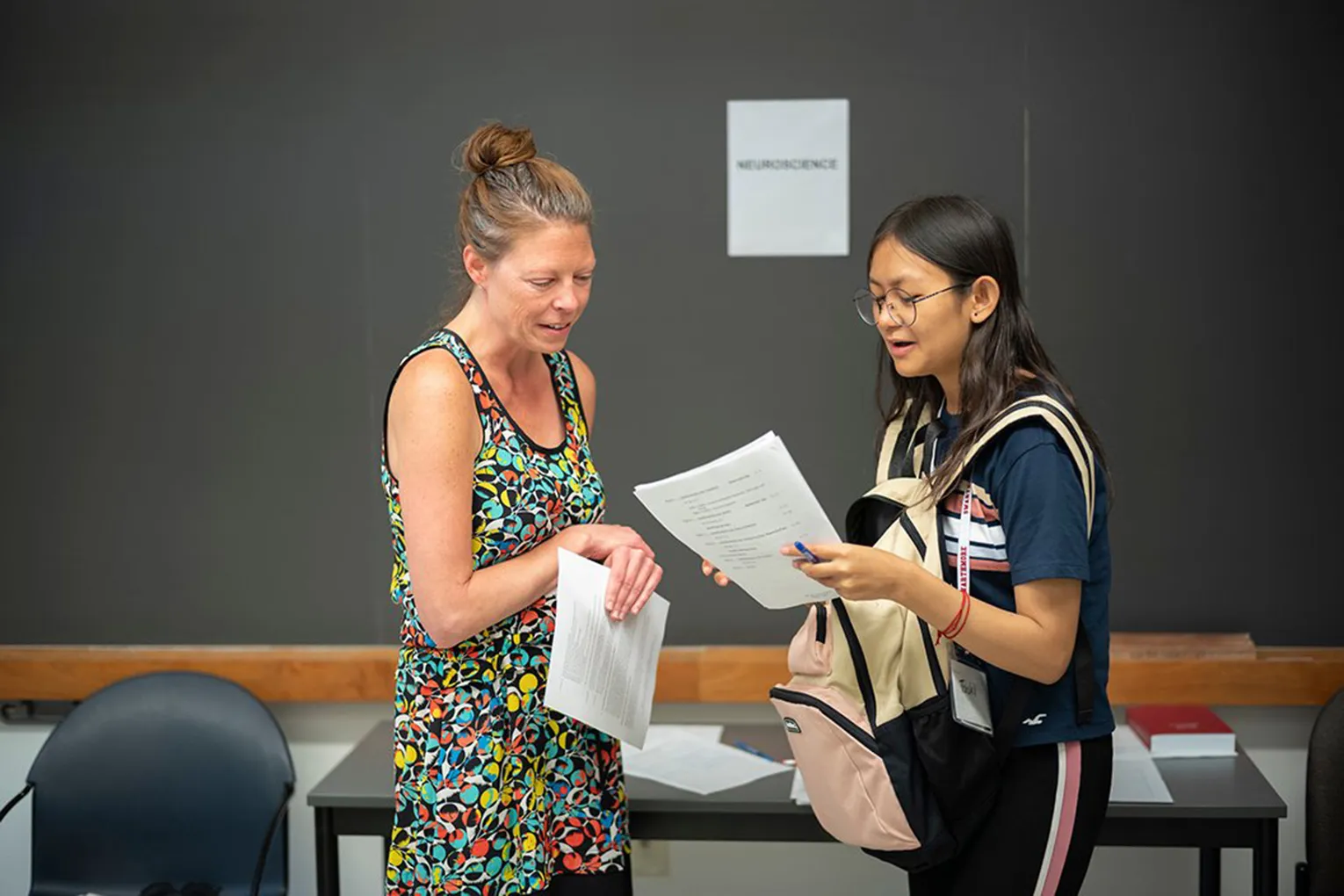Marigolds and Memories: Swarthmore Celebrates Día de los Muertos

The ofrenda was largely dedicated to people who had contributed to Scott Arboretum & Gardens as staff, donors, or volunteers, but at the top sat a photo of Homero Gómez González, to whom the Día de los Muertos event was dedicated.
The Spanish Department, Scott Arboretum & Gardens, Intercultural Center, and Libraries teamed up to produce two Día de los Muertos events for the campus community this year. Día de los Muertos is a Mexican holiday that takes place on November 1 and 2. During these days, it is believed that the souls of the dead are able to visit the living.
The first of the annual Día de los Muertos events took place on the afternoon of October 30 at the Wister Center and featured a wall-length ofrenda, or altar; presentations by two Spanish Department students; a table of Mexican-themed books curated by the Libraries, refreshments of horchata and pan de muertos, and beautiful flower arrangements provided by the Arboretum. It was well attended by Spanish faculty and students, Arboretum staff and members, and library staff.
The ofrenda was largely dedicated to people who had contributed to Scott Arboretum & Gardens as staff, donors, or volunteers, but at the top sat a photo of Homero Gómez González, to whom the Día de los Muertos event was dedicated.
Homero Gómez González was a Mexican activist and politician who worked tirelessly to protect monarch butterflies and the forests where they live in Michoacán.
Scroll down to the student speeches given by Sydney Haydu ’27 (in Spanish) and Hannah Lee ’27 (in English) at the bottom to learn more about him and Día de los Muertos.
The second Día de los Muertos event was a screening of the film Coco in the Martin Hall Screening Room that took place on November 2.
The speech from Thursday’s event:
“In the Indigenous theology of Mexico, the Day of the Dead represents the temporary return of the souls of the dead back to the world of the living. It is believed that during these days, the deceased return home to spend time with their loved ones and enjoy the offerings on their altars, which traditionally consisted of the foods they loved most when alive to stave off hunger during their journeys to and from Mictlán [an Aztec word for the underworld]. In this celebration, death does not mean absence, but a living presence among people.
The modern version of the Day of the Dead comes from a fusion of Indigenous beliefs and Catholic traditions brought by the Spanish during the colonization of Mexico. Ancient Native peoples, such as the Mexica, Mixtec, Zapotec, Tlaxcaltac, Totonac, and others adopted their rituals to the Christian calendar. Thus, the Day of the Dead is celebrated on November 1 and November 2.
According to Catholic traditions, the first is dedicated to All Saints Day, known as the Day of the ‘little dead’ or ‘little deceased,’ referring to children, and November 2 is dedicated to All Souls Day, the Day of the Adults.
Every November, Mexican families prepare offerings and altars decorated with cempasúchil flowers, a type of marigold; paper cut into various patterns [papel picado]; sugar skulls [calaveras de azúcar]; pan de muerto, or bread of the dead; mole; and their loved ones’ favorite dishes.
As in pre-Hispanic times, incense is used to scent and purify the space. It is also customary to visit cemeteries to cleanse and decorate the graves with flowers and candles, and sometimes to build small altars on the tombstones.
In ancient times, this act had profound significance, as it was believed to help souls find their way in the afterlife. Finally, according to tradition, to facilitate the souls’ return to Earth, cempazúchitl petals and candles are placed as a path that guides them from the cemetery to their former homes, preventing them from getting lost along the way.
Every year, we choose one important figure to honor, and this year, since the altar is at the Arboretum, we are celebrating the life of Homero Gómez González. Born on January 3, 1970, in the municipality of Ocampo, Michoacán he was a Mexican agricultural engineer, environmental activist and politician of Ocampo. He is recognized for his unrelenting work protecting the monarch butterfly and the forests that make up their habitat.
Despite coming from a family dedicated to logging, he radically changed his perspective to become an environmental advocate. As an administrator of the El Rosario sanctuary within the Monarch Butterfly Biosphere Reserve, he promoted the first nature programs, encouraged ecotourism as an economic alternative for local communities, and fought against illegal logging that threatened both the ecosystem as well as the livelihoods of the inhabitants.
His work contributed significantly to make the ecological and cultural significance of the monarch butterfly visible, which is a symbol of migration and regeneration in Mexico. Gómez succeeded in involving farmers and miners and in sustainable projects, demonstrating that conservation can generate social and economic benefits.
His disappearance and death in 2020 shocked the country and the world, turning him into a symbol of the environmental struggle against violence and impunity. Despite his tragic passing, his legacy continues to inspire conservation and environmental justice movements both in Michoacán and internationally.”



